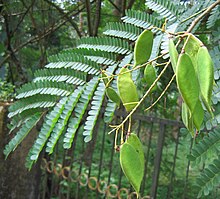Sappan wood
| Biancaea sappan | |
|---|---|
 |
|
| Leaves and fruits | |
| Scientific classification | |
| Kingdom: | Plantae |
| (unranked): | Angiosperms |
| (unranked): | Eudicots |
| (unranked): | Rosids |
| Order: | Fabales |
| Family: | Fabaceae |
| Genus: | Biancaea |
| Species: | B. sappan |
| Binomial name | |
|
Biancaea sappan (L. 1753) Tod. 1875 |
|
| Synonyms | |
|
|
Biancaea sappan is a species of flowering tree in the legume family, Fabaceae, that is native to tropical Asia. Common names in English include sappanwood and Indian redwood. Sappanwood is related to Brazilwood (P. echinata), and was originally called "brezel wood" in Europe.
Disease : Twig dieback (Lasiodiplodia theobromae)
This plant has many uses. It has antibacterial and anticoagulant properties. It also produces a valuable reddish dye called brazilin, used for dyeing fabric as well as making red paints and inks. Slivers of heartwood are used for making herbal drinking water in various regions, such as Kerala and Central Java, where it is usually mixed with ginger, cinnamon, and cloves. The heartwood also contains juglone (5-hydroxy-1,4-naphthoquinone), which has antimicrobial activity. Homoisoflavonoids (sappanol, episappanol, 3'-deoxysappanol, 3'-O-methylsappanol, 3'-O-methylepisappanol and sappanone A) can also be found in B. sappan.
The wood is somewhat lighter in color than Brazilwood and other related trees. Sappanwood was a major trade good during the 17th century, when it was exported from Southeast Asian nations (especially Siam) aboard red seal ships to Japan.
![]() This article incorporates text from a publication now in the public domain: Chisholm, Hugh, ed. (1911). "". Encyclopædia Britannica. 24 (11th ed.). Cambridge University Press.
This article incorporates text from a publication now in the public domain: Chisholm, Hugh, ed. (1911). "". Encyclopædia Britannica. 24 (11th ed.). Cambridge University Press.
...
Wikipedia

